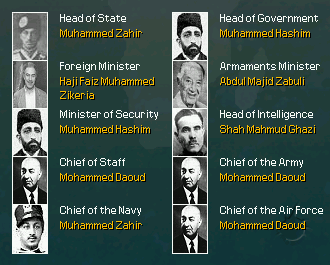Afghanistan
From Kaiserreich
| ||||

| ||||
|
| ||||
| Official Language | Dari Persian and Pashto | |||
| Capital | Kabul | |||
| Head of State | Mohammed Zaher Shah | |||
| Head of Government | Mohammad Hashim | |||
| Establishment - Independance from Britain | August 19, 1919 | |||
| Government | Autocratic monarchy | |||
| Currency | Afghan Afghani | |||
| Area | About 800.000 km² | |||
| Population | About 15 millions | |||
Afghanistan is a country in Central Asia. It borders Turkestan to the north, Xibei Lianbang Yiyuan to the east, Delhi to the south and Persia to the west.
Contents |
History
Afghanistan was always a troubled region for the British to maintain control of. An important part of the 'Great Game' between the British Empire and the Russian Czars during the 19th century, every attempt to fully subdue the country ran into fierce resistance. By 1880, however, after the Second Anglo-Afghan war, the emir of Afghanistan finally agreed to allow British control over the country's foreign affairs. But in the midst of the Weltkrieg, the Afghani emir was assassinated and his son launched yet another war against Britain on the sixth of May 1919 until the war-weary British agreed to fully withdraw from the country on the eighth of August 1919. The Durand Line was reaffirmed as the political boundary between Afghanistan and British India and the Afghans agreed not to foment trouble on the British side and to adopt a strict neutrality in regard of the Weltkreig. By 1923, a constitution was drawn up and the long process of modernization began....perhaps a bit too quickly. The newly crowned King was deposed by a revolt from Afghani tribesman angry at his attempts to do away with centuries old traditions, forcing him into exile by the end of the 1920's. He was replaced by King Nadir Shah, who kept his continuing reforms to a more acceptable pace. During these turbolent times and taking advantage of the break-up of the British Empire, Afghanistan was also able to seize several provinces formerly part of British India. On 8 November 1933 Nadir Shah was assassinated and his son Mohammed Zaher Shah has inherited the throne, but despite lingering resentments among tribal leaders there is no sign of turmoil for the country in the immediate future.
Politics
|
Shah of Afghanistan: Mohammed Zaher Shah (born 15 October 1914)
Prime Minister and Minister of Interior: Mohammad Hashim (born 1885)
Minister of Foreign Affairs: Haji Faiz Muhammad Zikeria (born 1892)
Minister of Finance: Abdul Majid Zabuli (born 14 August 1896)
Chief of Military Intelligence: Shah Mahmud (born 1890)
Commander-in-Chief of the Afghan Army: Mohammed Daoud (born 18 July 1909)
Military
Army
The army is mainly composed of militias from local tribes.
Air Force
A military air program was never attempted, as the country lacks an airport.
Foreign relations
Friendly relations with Ottoman Empire, Turkestan, Persia and Heshemite Arabia.
Unfriendly relations with Delhi, Bhartiya Commune, Commune of France and Union of Britain


